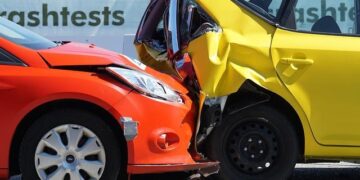Table of Contents
The First Domino: Answering Your Core Question and Unpacking the Concept of “Liability”
The Misleading Phrase and the Million-Dollar Question
I’ll never forget the first time I tried to get a car insurance quote on my own.
I was in my early twenties, fresh out of college, and the whole process felt like a final exam I hadn’t studied for.
I sat on my bed, phone pressed to my ear, talking to an agent who was patient but clearly dealing with a novice.
I knew I needed insurance to be legal, and I had a vague notion that it should cover accidents.
So, when he asked what kind of coverage I wanted, I said with unearned confidence, “Well, I definitely need collision.” He agreed.
“And,” I continued, trying to sound knowledgeable, “I’ll need that limited collision for the other guy’s car, too.”
There was a pause.
A long one.
“Sir,” he said slowly, “I think you mean ‘liability coverage’.”
I had no idea what he was talking about.
To me, a collision was a collision.
If my car hit another car, wasn’t that a collision for both of us? Why did it have a different name? That conversation was the first domino in a long, and frankly, expensive, journey to understanding what car insurance really Is. It’s a journey that took me from a state of profound confusion to one of clarity, but not before I made a critical mistake that cost me thousands of dollars and years of financial stress.
I wrote this guide so you don’t have to learn the hard way, like I did.
Let’s start by clearing up the confusion that plagued me on that phone call.
The insurance you’re looking for, the kind that covers damage you cause to another person’s car or their property, is officially called Property Damage Liability (PDL) Insurance.1
It is one of the two fundamental components of your overall
Auto Liability Coverage.
The Foundation of It All: What “Liability” Really Means
The word that tripped me up—”liability”—is the absolute cornerstone of the insurance world.
In the simplest terms, “liability” is just a legal and financial word for “responsibility”.3
When you are “liable” for an accident, it means you are financially responsible for the damages you caused.
Because the cost of those damages can be catastrophic—easily tens or even hundreds of thousands of dollars—the law doesn’t leave it to chance.
In nearly every state, you are legally required to prove you can cover those costs, a concept known as “financial responsibility”.4
For the vast majority of us, the way we prove this is by buying auto liability insurance.4
When you purchase liability coverage, you are essentially paying an insurance company to assume this massive financial risk on your behalf.5
If you cause an accident, your insurer steps in and pays for the damages you’re responsible for, up to the limits you’ve selected on your policy.
This is the core function of car insurance: to shield your personal assets from the devastating costs of an at-fault accident.
The Two Pillars of Your Financial Shield: Bodily Injury and Property Damage
Your auto liability coverage is not a single, monolithic thing.
It’s a shield built from two distinct, yet inseparable, pillars that protect you from two different types of damage you can cause.7
- Bodily Injury Liability (BI): This pillar covers the costs associated with injuries you cause to other people in an accident. It’s designed to pay for their medical bills, rehabilitation costs, lost wages if they can’t work, and even intangible costs like “pain and suffering”.7
- Property Damage Liability (PDL): This is the pillar that directly addresses your original question. It covers the cost to repair or replace things you damage with your vehicle. This most commonly means the other person’s car, but its scope is far broader than most people realize.7
Your confusion, and mine all those years ago, stemmed from a simple but critical misunderstanding.
The insurance industry uses precise, legalistic terms, while we, as consumers, tend to think in functional, real-world terms like “fixing my car” versus “fixing their car.” The term “collision coverage” applies to fixing your car.
The term “property damage liability” applies to fixing their car and their property.
Understanding this single distinction is the first and most important step toward becoming an empowered insurance consumer.
Property Damage Liability (PDL) Under the Microscope: What It Is, What It Does, and What It Doesn’t Do
The Official Definition and Scope of PDL
Now that we’ve placed PDL within the larger framework of liability, let’s put it under the microscope.
Property Damage Liability (PDL) is the specific component of your auto insurance policy that pays for the physical damage you cause to another party’s property while operating your vehicle, provided you are found legally at fault for the accident.1
The key phrase here is “another party’s property.” This is a one-way street; it only ever pays out to others.
But what, exactly, constitutes “property” in the eyes of an insurer? The definition is surprisingly comprehensive and goes far beyond just the other driver’s vehicle.
Your PDL coverage can be called upon to pay for:
- Repairs to Other Vehicles: This is the most common type of PDL claim, covering everything from a minor bumper scratch to the total replacement cost of another person’s car, truck, or motorcycle.10
- Damage to Structures: If you lose control and hit a building, your PDL covers the repairs to that house, storefront, or garage.11
- Damage to Fixtures and Landscaping: This includes a huge range of objects you might hit, such as fences, mailboxes, lamp posts, guardrails, street signs, and even trees or landscaping on someone’s lawn.9
- Ancillary and Legal Costs: In many cases, PDL can also cover related expenses. This might include paying for a rental car for the other driver while their vehicle is in the shop.8 Crucially, it also typically covers the legal fees to defend you in court if the other party sues you over the property damage you caused.9
A Real-World Scenario: How a PDL Claim Unfolds
To make this tangible, let’s walk through a simple, everyday accident.
Imagine I’m backing out of a driveway, get distracted by my phone for a split second, and accidentally hit my neighbor’s parked car.
The impact is minor, but it’s enough to dent their door and, unfortunately, I also backed over their ornate brick mailbox, crumbling it.
Here’s how my PDL coverage would spring into action:
- The Accident: The event occurs. I’ve damaged both a vehicle and a piece of property (the mailbox).
- Fault Determination: Since I was backing up and hit a stationary object, I am clearly at fault. I exchange insurance information with my neighbor.
- The Claims: My neighbor files two claims against my auto insurance policy: one for the damage to their car’s door and another for the destruction of their mailbox.
- The Payout: My insurance company’s adjuster assesses the damage. They determine the car repair will cost $1,800 and replacing the mailbox will cost $700, for a total of $2,500. As long as my PDL coverage limit is above $2,500, my insurer pays the full amount directly to the repair shop and the mason.
The most important part of this scenario for me, the at-fault driver, is this: I pay nothing out-of-pocket for these specific repairs.
A key feature of all liability coverage, both BI and PDL, is that there is no deductible for me to pay.15
The purpose of a deductible is to have you share in the cost of repairing
your own property.
Since liability is about repairing someone else’s, the concept doesn’t apply.
My premiums might increase at renewal, but for the claim itself, my insurance handles the entire covered cost.
The Hard Boundaries: What PDL Explicitly Excludes
This is where the most dangerous and costly misunderstandings occur.
The protection offered by PDL is powerful, but its boundaries are rigid and absolute.
Getting this wrong is the single fastest way to find yourself in a financial nightmare.
Property Damage Liability will NEVER pay for:
- Damage to your own car: This is the cardinal rule. If you are at fault, PDL does nothing to fix your vehicle. That is the exclusive job of a separate coverage called Collision Coverage.1
- Your own medical bills (or those of your passengers): PDL is for property, not people. Your own injuries are covered by other parts of your policy, such as Medical Payments Coverage (MedPay) or Personal Injury Protection (PIP), depending on your state.14
- Damage from non-collision events: If your car is stolen, vandalized, damaged by a hailstorm, or you hit a deer, PDL offers no help. These “acts of God” or “other-than-collision” events are covered by Comprehensive Coverage.17
- Intentional Damage: Insurance is designed to cover accidents. If you intentionally damage someone’s property with your vehicle, it’s considered a criminal act, not an insurable event, and your policy will not cover it.13
The most common and devastating mistake is assuming that because you have “property damage” coverage, you are somehow covered for any damage to any car.
This is a false sense of security.
The “liability” part of the name is the most important word; it means this coverage only ever looks outward, protecting you from claims made by others.
It never looks inward to cover your own losses.
The Auto Insurance Matrix: A Clear, Jargon-Free Comparison of Your Core Options
Building Your Policy Like a Set of Armor
After my initial fumbling and later, my costly accident, I finally had an epiphany.
I had been thinking about car insurance as a confusing menu of à la carte items.
That was the wrong mental model.
The right way to think about it is like building a suit of armor.
Each piece has a distinct and vital purpose, and you are dangerously exposed without the complete set.
- Liability Coverage (BI and PDL) is your mandatory breastplate. It’s the core piece of armor that protects you from legal and financial attacks from others. You can’t legally enter the battlefield (the road) without it.
- Collision Coverage is your helmet. It protects you—specifically, your most valuable asset in the crash, your car—from the direct impact of an accident.
- Comprehensive Coverage is your shield. It protects your car from all the other dangers on the battlefield that aren’t direct collisions—the arrows of hail, the fire of vandalism, the pitfall of theft.
You wouldn’t go into battle with just a breastplate, yet millions of drivers are on the road with only liability coverage, leaving themselves completely vulnerable.
The Master Comparison
To permanently dispel the confusion that started this journey, let’s lay out the four primary types of auto insurance coverage side-by-side.
This matrix is designed to be the ultimate, unambiguous clarifier, showing how each piece of “armor” functions.
Table 1: The Core Coverage Comparison Matrix
| Coverage Type | What It Covers | Whose Property/Person? | When Does It Apply? | Required by Law? |
| Property Damage Liability | Damage to vehicles, buildings, fences, etc. | The other party’s | When you are at fault in an accident | Yes (in nearly all states) 5 |
| Bodily Injury Liability | Medical bills, lost wages, pain & suffering | The other party’s | When you are at fault in an accident | Yes (in nearly all states) 18 |
| Collision | Damage to your own vehicle from a collision | Your own | Regardless of fault | No (but often required by lenders) 19 |
| Comprehensive | Theft, vandalism, fire, hail, animal collision | Your own | In non-collision incidents | No (but often required by lenders) 20 |
Deep Dive: PDL vs. Collision Coverage
This is the distinction that started it all.
The difference is simple but profound.
- The Core Question: Whose car are we talking about? If it’s their car that you damaged, your PDL pays. If it’s your car, your Collision coverage pays.2
- The Role of Fault: Your PDL only ever pays out when you are deemed at fault. Your Collision coverage, however, will pay to fix your car even if you are 100% at fault (like hitting a pole). It also pays if the other driver is at fault but is uninsured or their insurance is slow to pay; your company will then pursue the at-fault party to get its money back, a process called subrogation.19
- The Deductible Difference: As mentioned, your PDL coverage has no deductible for you. Your Collision coverage always has a deductible—an amount you must pay out-of-pocket (e.g., $500 or $1,000) before the insurance company pays the rest.22
Deep Dive: PDL vs. Comprehensive Coverage
Think of these as covering two completely different categories of risk.
- Accident vs. “Other Perils”: PDL is exclusively for damage you cause in an accident involving your moving vehicle. Comprehensive, often called “other-than-collision” coverage, is for nearly everything else that can damage your car when it’s not in a typical collision. This includes theft, vandalism, fire, floods, hailstorms, falling trees, and hitting an animal.19 If a tree branch falls on your parked car, your Comprehensive coverage handles it. If you accidentally drive your car into that same tree, your Collision coverage handles it. Your PDL is never involved in damage to your own car.
Deep Dive: PDL vs. Bodily Injury Liability (BI)
This is the easiest distinction within your liability “breastplate.”
- Property vs. People: It’s as simple as that. PDL pays for bent metal, broken fences, and damaged structures. BI pays for broken bones, hospital stays, and lost wages.7 They are two sides of the same liability coin, working together to protect you from claims made by others. On your insurance policy, you will see separate coverage limits listed for each.
The Limits of the Law: Why Your State’s Minimum Coverage is a Financial Trap
Understanding Coverage Limits: Your Financial Firewall
Every liability coverage on your policy comes with a “limit.” This is the absolute maximum amount your insurance company will pay out on your behalf for a single covered claim.6
Think of it as the height of your financial firewall.
If a fire (a lawsuit) is bigger than your firewall, everything you own on the other side is at risk.
Auto liability limits are typically expressed as a series of three numbers, like 25/50/25.
Here’s how to decode that:
- $25,000: The maximum Bodily Injury (BI) liability coverage for any one person you injure.
- $50,000: The maximum Bodily Injury (BI) liability coverage for all persons injured in a single accident.
- $25,000: The maximum Property Damage Liability (PDL) coverage for all property damaged in a single accident.2
The third number is our focus here.
In this example, if you cause a multi-car pileup, your insurer will pay a maximum of $25,000 total to repair or replace all the vehicles and property you damaged.
Anything above that $25,000 comes directly out of your pocket.
The Shocking Reality of State Minimums
Here we arrive at the heart of my big, costly mistake.
Like most young people, I assumed that if I bought the minimum amount of insurance required by my state, I was “covered.” This is one of the most dangerous financial myths in existence.
State laws mandate that you carry liability insurance, but the minimum limits they require are often so low they are practically useless in a modern accident.2
Consider the legally required PDL minimums in several large states:
- California: $5,000 (though this is set to increase).25
- Pennsylvania: $5,000.27
- Massachusetts: $5,000.27
- Florida: $10,000.27
- New York: $10,000.26
- Texas: $25,000.27
These numbers should be terrifying.
The idea that these laws are designed for robust consumer protection is a fallacy.
They are, in reality, a societal backstop, a bare-minimum requirement to ensure there’s some money available after an accident, reducing the burden on public courts and services.
They create a veneer of responsibility that gives drivers a profoundly false sense of security.
Because the state mandates it, people assume it’s adequate.
This official endorsement of an inadequate amount is a financial trap, and I walked right into it.
The Million-Dollar Gap: My Story
Early in my driving career, to save money, I carried my state’s minimum liability coverage: 15/30/10.
That meant I had a measly $10,000 in Property Damage Liability.
One rainy evening, I was driving home on the freeway.
Traffic stopped suddenly ahead.
I slammed on my brakes, but my tires hydroplaned on the wet pavement.
I rear-ended the car in front of me, a late-model sedan, pushing it into the brand-new luxury SUV in front of it.
The damage to my own car was bad, and since I didn’t have collision coverage, I had to scrap it.
But that was the least of my problems.
The sedan I hit had over $8,000 in damage.
The luxury SUV, with its complex sensors and custom paint, had over $32,000 in damage.
The total property damage I had caused was $40,000.
My insurance company paid out the full $10,000 limit of my PDL coverage.
And then I received a letter from the other drivers’ insurance companies.
I was personally liable for the remaining $30,000.
I was 23 years old, with no savings.
The result was a lawsuit, a judgment against me, and years of having my wages garnished.
A single, split-second mistake on a wet road, combined with my ignorance about insurance limits, altered the course of my financial life for the next decade.
My story is not unique.
With the average cost of a new car soaring and repair costs for even minor fender-benders running into the thousands due to sensors, cameras, and specialized materials, a $5,000 or $10,000 PDL limit is a recipe for disaster.30
It might not even be enough to cover the damage to one single car, let alone a multi-vehicle accident.
The Expert Standard: Insuring to Your Net Worth
The epiphany came during a meeting with a financial advisor a few years after my accident.
I was explaining my situation, and he stopped me.
“You’re thinking about insurance all wrong,” he said.
“Its purpose isn’t to make you legal.
Its purpose is to build a firewall around everything you own and everything you will ever earn.”
This was the key.
The professional standard for choosing liability limits has nothing to do with the state minimum.
It has everything to do with protecting your assets.3
The rule of thumb is that you should carry enough liability insurance to cover your
total net worth.
If you have $150,000 in assets (savings, investments, home equity), and you cause an accident with $200,000 in damages, a plaintiff’s attorney will see your assets as a ripe target.
But if you have a $300,000 liability policy, the insurance company has enough money on the table to settle the claim, and there is far less incentive to come after you personally.
Debunking Dangerous Myths: The Costly Misconceptions That Can Wreck Your Finances
My journey revealed that the insurance world is rife with myths and misleading slang.
These aren’t just harmless misunderstandings; they are cognitive traps that lead directly to the kind of underinsurance that ruined my finances.
Our brains are wired to prefer simple, certain-sounding ideas, but in the complex world of risk management, that instinct can be a liability.
The “Full Coverage” Fallacy
This is the most pervasive and dangerous myth of all.
You will hear the term “full coverage” from friends, family, and even car salespeople.
It has no legal or official definition.16
It is a colloquialism, a piece of slang.
Typically, when people say “full coverage,” they mean a policy that includes the big three: Liability, Collision, and Comprehensive.34
The problem is that the term says absolutely nothing about the
limits of that liability coverage, which is the most important part.
You can have a “full coverage” policy with state-minimum liability limits of $5,000 for property damage.
While your own car might be protected, you are still exposed to financial ruin from the damage you cause to others.34
Never ask for “full coverage.” Instead, specify the exact coverages and, more importantly, the exact limits you want.
Myth #1: “My liability insurance covers my car if the other driver is uninsured.”
- Fact: Absolutely false. Your liability coverage only pays others. If a driver with no insurance hits you and you only have liability coverage, you are on your own to repair your car. To be protected in this common scenario, you need one of two things: Collision Coverage (which pays for repairs regardless of fault) or a specific, separate coverage called Uninsured Motorist Property Damage (UMPD).4
Myth #2: “If I lend my car to a friend, their insurance covers any accident.”
- Fact: Generally false. In the vast majority of states, the rule is that auto insurance follows the vehicle, not the driver.31 If you give your friend permission to drive your car and they cause an accident, it is
your PDL insurance that is on the hook as the primary coverage. This claim goes on your record and can dramatically increase your premiums for years to come. Only lend your car to someone whose driving you trust as much as your own.
Myth #3: “I’m a safe driver, so I only need the minimum required coverage.”
- Fact: This is a classic case of optimism bias, confusing personal skill with the management of external risk. Even the world’s best driver can be a victim of circumstances: a sudden patch of black ice, a deer darting into the road, a tire blowout, or a momentary distraction. Your liability insurance isn’t for the dozens of minor mistakes you avoid; it’s for the one catastrophic, unforeseen event you don’t.31 The financial consequences of hitting a new luxury car are the same whether you’re a professional racer or a nervous teenager. Your driving record affects your premium, but it shouldn’t dictate your coverage limits.
Myth #4: “The type of car I drive doesn’t affect my liability premium.”
- Fact: This is mostly true, but with an important nuance. The value and repair cost of your own car directly impacts your Collision and Comprehensive premiums, but not your liability premium. However, insurers are in the business of pricing risk, and they may use the type of vehicle you drive as a statistical proxy for your driving behavior. A person who buys a high-performance sports car may be statistically more likely to drive aggressively than someone who buys a minivan, which could lead to a higher liability premium.40 The far more significant factor, however, is not the car you drive, but the cars you drive
around. If you live and commute in an affluent area filled with expensive vehicles, your risk of causing a high-dollar PDL claim is much greater, and that will be reflected in your rates.
From Victim to Architect: Strategically Fortifying Your Financial Shield
My painful financial education ultimately empowered me.
I went from being a passive, confused victim of the insurance system to an active architect of my own financial security.
You can do the same.
Protecting yourself isn’t about finding the cheapest premium; it’s about making a strategic investment in your peace of mind.
Your Action Plan: A Step-by-Step Guide to Choosing the Right PDL Limit
- Calculate Your Net Worth: This is your starting point. You cannot protect what you have not measured. Use this simple formula: (Your Assets: Cash + Investments + Home Equity + Value of Major Possessions) – (Your Liabilities: Mortgage + All Loans + Credit Card Debt) = Your Net Worth. This number is the absolute floor for your liability coverage limits.3
- Assess Your Environment and Risk Profile: Go beyond your net worth. Do you commute daily in heavy, high-speed traffic? Do you live in an area where luxury cars are common? Do you have young, inexperienced drivers in your household? Do you own a business or have other factors that make you a more attractive target for a lawsuit? If you answer yes to any of these, you should consider limits that are even higher than your current net worth.
- Get Multiple Quotes for Higher Limits: When shopping for insurance, don’t just accept the default quote. Ask the agent or use the online tool to price out several different liability levels. Specifically, ask for quotes with PDL limits of $50,000, $100,000, and $250,000. You will likely be shocked at how small the premium increase is to double or even quintuple your protection. The first dollar of coverage is the most expensive; additional layers of protection are surprisingly affordable.16
Advanced Protection: When to Consider CSL and Umbrella Policies
For those with significant assets or a higher risk profile, there are two advanced tools for fortifying your financial shield.
- Combined Single Limit (CSL) Policy: Instead of the standard split limits (like 100/300/100), a CSL policy gives you one large pool of liability coverage—for example, $300,000 or $500,000—that can be used as needed for either bodily injury or property damage in an accident. If you cause an accident with $200,000 in property damage but no injuries, a CSL policy can cover the entire amount. A standard policy with a $100,000 PDL limit would leave you $100,000 short. CSL policies offer greater flexibility and are highly recommended for anyone with a net worth approaching six figures or more.8
- Personal Umbrella Policy: This is the ultimate layer of financial armor. An umbrella policy is a separate insurance policy that sits on top of both your auto and homeowners insurance. It only kicks in after the liability limits on your underlying policies have been exhausted. These policies are typically sold in increments of $1 million and are remarkably inexpensive for the immense protection they provide. If you have a net worth of several hundred thousand dollars or more, a personal umbrella policy is not a luxury; it is an essential component of responsible financial planning.
Conclusion: The Epiphany of True Coverage
That confusing phone call so many years ago, when I asked for “collision for the other guy’s car,” was the start of a difficult but necessary education.
The painful lesson of my subsequent accident and the years of financial struggle that followed led me to a simple, powerful epiphany: The cheapest insurance policy isn’t the one with the lowest monthly premium.
The cheapest insurance is the one that prevents a single mistake on the road from destroying a lifetime of hard work and future earnings.
The goal of buying insurance isn’t just to be “legal”; it’s to remain “whole.” True coverage isn’t a piece of paper in your glove box or a monthly debit from your bank account.
It is the quiet confidence that comes from knowing you have built a strong, reliable firewall between your family’s financial future and the unpredictable chaos of the road.
It is, in the end, peace of mind.
And that is a value that can’t be found on any quote.
Works cited
- What Is Property Damage Liability? | Allstate, accessed August 17, 2025, https://www.allstate.com/resources/car-insurance/property-damage-liability-insurance
- What Is Property Damage Liability Insurance? | Progressive, accessed August 17, 2025, https://www.progressive.com/answers/property-damage-liability/
- Liability Car Insurance: What It Covers and How Much You Need – NerdWallet, accessed August 17, 2025, https://www.nerdwallet.com/article/insurance/auto/liability-car-insurance
- Automobile Insurance Text Version – California Department of Insurance, accessed August 17, 2025, https://www.insurance.ca.gov/01-consumers/105-type/95-guides/01-auto/auto101.cfm
- What Is Liability Insurance Coverage? – Progressive, accessed August 17, 2025, https://www.progressive.com/answers/liability-insurance/
- Types of Car Insurance Coverage – Travelers Insurance, accessed August 17, 2025, https://www.travelers.com/car-insurance/coverage
- Liability Car Insurance | Allstate, accessed August 17, 2025, https://www.allstate.com/resources/car-insurance/liability-car-insurance-cover
- What is Liability Car Insurance & What Does It Cover? – GEICO, accessed August 17, 2025, https://www.geico.com/information/aboutinsurance/auto/liability-insurance/
- What is Liability Car insurance Coverage? – Progressive, accessed August 17, 2025, https://www.progressive.com/answers/auto-liability-insurance/
- Property Damage Liability: What Is It? | Liberty Mutual, accessed August 17, 2025, https://www.libertymutual.com/vehicle/auto-insurance/coverage/property-damage-coverage
- What is Property Damage Liability? – COUNTRY Financial, accessed August 17, 2025, https://www.countryfinancial.com/en/planning/common-topics/insurance-coverage/what-is-property-damage-liability.html
- What is Property Damage Liability Insurance – AAA Northern California, accessed August 17, 2025, https://mwg.aaa.com/insurance/car/articles/property-damage-liability
- What Is Property Damage Coverage and How Does It Work? – MAPFRE Insurance, accessed August 17, 2025, https://www.mapfreinsurance.com/blog/property-damage-coverage/
- Liability Car Insurance: What It Covers and How Much It Costs – Bankrate, accessed August 17, 2025, https://www.bankrate.com/insurance/car/liability-car-insurance/
- What is Property Damage Liability Insurance | Dairyland Auto, accessed August 17, 2025, https://www.dairylandinsurance.com/resources/property-damage-liability-insurance
- Auto Insurance Liability: Frequently asked questions | Liberty Mutual, accessed August 17, 2025, https://www.libertymutual.com/insurance-resources/auto/auto-liability
- Liability vs. Full Coverage Car Insurance: Which Is Better? – Experian, accessed August 17, 2025, https://www.experian.com/blogs/ask-experian/liability-vs-full-coverage-car-insurance/
- Car Insurance Requirements by State | Progressive, accessed August 17, 2025, https://www.progressive.com/answers/state-car-insurance-information/
- Comprehensive vs. collision insurance: Is your car protected? – Higginbotham, accessed August 17, 2025, https://www.higginbotham.com/blog/comprehensive-vs-collision-insurance/
- Comprehensive vs. collision insurance: What’s the difference? – Progressive, accessed August 17, 2025, https://www.progressive.com/answers/comprehensive-vs-collision-insurance/
- Collision, Comprehensive and Liability Insurance: What You Need to Know – NCMIC’s, accessed August 17, 2025, https://www.ncmic.com/insurance/personal/vehicle/collision-comprehensive-and-liability-insurance-what-you-need-to-know/
- Liability, Collision, & Comprehensive Coverage 101 – California Casualty, accessed August 17, 2025, https://mycalcas.com/2021/08/liability-collision-comprehensive-coverage-101/
- The Difference Between Collision and Comprehensive Coverage | Maryland Car Accident Lawyer | The Poole Law Group, accessed August 17, 2025, https://www.poolelg.com/blog/the-difference-between-collision-and-comprehensive-coverage-maryland-car-accident-lawyer.cfm
- Insurance Coverage Guide: What Does Car Insurance Cover? | The …, accessed August 17, 2025, https://www.thezebra.com/auto-insurance/coverage/
- How Much Car Insurance Does Each State Require? – Matic, accessed August 17, 2025, https://matic.com/blog/how-much-car-insurance-does-each-state-require/
- Automobile Financial Responsibility Laws By State | III – Insurance Information Institute, accessed August 17, 2025, https://www.iii.org/automobile-financial-responsibility-laws-by-state
- The Minimum Required Car Insurance by State – NerdWallet, accessed August 17, 2025, https://www.nerdwallet.com/article/insurance/minimum-car-insurance-requirements
- Minimum Car Insurance Requirements By State (2025) – Thompson Law Injury Lawyers, accessed August 17, 2025, https://1800lionlaw.com/minimum-car-insurance-requirements-by-state/
- Auto insurance guide – Texas Department of Insurance, accessed August 17, 2025, https://www.tdi.texas.gov/pubs/consumer/cb020.html
- Property Damage Liability | PA Auto Insurance – Edgar Snyder & Associates, accessed August 17, 2025, https://www.edgarsnyder.com/resources/property-damage-liability
- Auto Insurance: Common Myths – Oklahoma Insurance Department, accessed August 17, 2025, https://www.oid.ok.gov/wp-content/uploads/2019/11/021513_CC-Auto-Insurance-Myths.pdf
- Insurance Myths | Mass.gov, accessed August 17, 2025, https://www.mass.gov/news/insurance-myths
- Top 6 Mistakes People Make When Buying Auto Insurance, accessed August 17, 2025, https://bailyagency.com/blog/auto-insurance-buying-mistakes/
- How do so many not know they only have liability coverage? : r/Insurance – Reddit, accessed August 17, 2025, https://www.reddit.com/r/Insurance/comments/1ixirlc/how_do_so_many_not_know_they_only_have_liability/
- What is considered full coverage? : r/Insurance – Reddit, accessed August 17, 2025, https://www.reddit.com/r/Insurance/comments/19cmara/what_is_considered_full_coverage/
- Rant: There is NO such thing as “Full Coverage” : r/Insurance – Reddit, accessed August 17, 2025, https://www.reddit.com/r/Insurance/comments/1gv66aw/rant_there_is_no_such_thing_as_full_coverage/
- Liability vs full coverage : Insurance – Reddit, accessed August 17, 2025, https://www.reddit.com/r/Insurance/comments/17trfec/liability_vs_full_coverage/
- Auto Insurance: Full or Basic? : r/ToyotaHighlander – Reddit, accessed August 17, 2025, https://www.reddit.com/r/ToyotaHighlander/comments/zlkubx/auto_insurance_full_or_basic/
- Should I just have liability insurance? – Reddit, accessed August 17, 2025, https://www.reddit.com/r/Insurance/comments/1eoqi0z/should_i_just_have_liability_insurance/
- Does the car make any difference when purchasing liability insurance? – Reddit, accessed August 17, 2025, https://www.reddit.com/r/Insurance/comments/19bk0xe/does_the_car_make_any_difference_when_purchasing/






